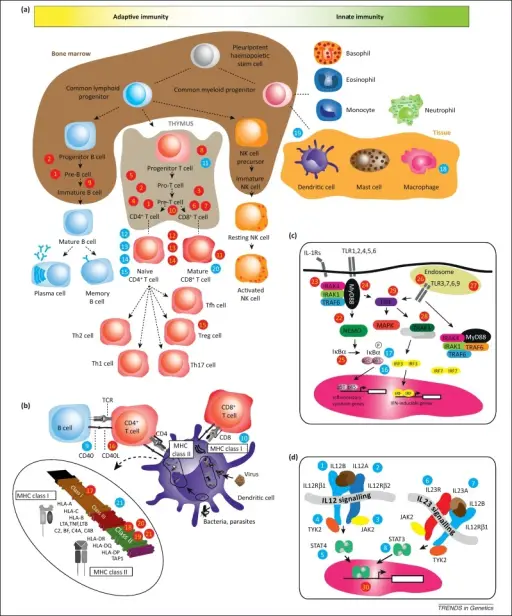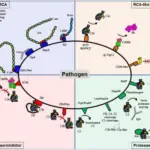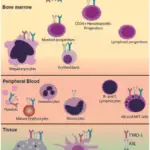Defects in adaptive immunity are failure of the recognition of specific “non-self” antigens, the failure of generation of pathogen-specific immunologic effector pathways and the failure of development of an immunologic memory. Examples of defects in adaptive immunity include IgG subclass deficiency, common variable immunodeficiency (CVID), transient hypogammaglobulinemia.
What are Defects in Adaptive Immunity?

Overview of key mediators of innate and adaptive immunity, development, and signalling. This is presented to provide context for genetic variants implicated in different Mendelian diseases with immune phenotypes (indicated by red filled circles numbered from 1 to 30), and common autoimmune diseases (blue filled circles numbered from 1 to 21). These numbers correspond to the diseases described in Figures 2 and 3. (a) Development of the myeloid and lymphoid lineages is shown together with key cell types involved in innate and adaptive immunity. (b) The role of an antigen-presenting cell (illustrated here for a dendritic cell) is shown, including antigen presentation via the endogenous pathway (MHC class I molecules) or the exogenous pathway (MHC class II molecules). The MHC gene locus is shown in terms of the classical class I and class II regions, with the intervening class III region. (c) Toll-like receptor signalling is a key component of the innate immune response involved in pathogen recognition (Box 1). (d) IL-12/IL-23 receptors and the JAK–STAT signalling pathways are central to the cytokine cascade and inflammatory response together with modulation/expansion of Th17 cells. Genetic variation in genes encoding different proteins in these pathways has been associated with autoimmunity by recent GWAS implicating dysregulation of IL-12 signalling (Th1 cells) and IL-23 signalling (Th17 cells) [6]. Abbreviations: IKK, inhibitor of κ light polypeptide gene enhancer in B cells kinase; IL-1Rs, interleukin-1 receptors; IRAK, IL-1R-associated kinase; IRF, interferon regulatory factor; JAK, Janus kinase; MHC, major histocompatibility complex; MyD88, myeloid differentiation primary-response protein 88; NEMO, NF-κB essential modulator; NK cell, natural killer cell; STAT, signal transducer and activator of transcription; TCR, T cell receptor; Tfh, follicular helper T cell; Th, T helper cell; TLR, Toll-like receptor; TRAF, TNF receptor-associated factor; TRAM, TRIF-related adaptor molecules; Treg, regulatory T cell; TYK, tyrosine kinase. Genomic modulators of the immune response. Knight JC - Trends in genetics : TIG (2012). Not Altered. CC.


